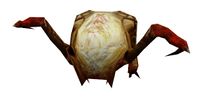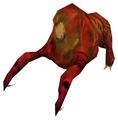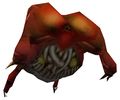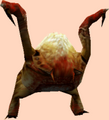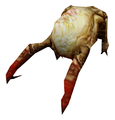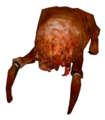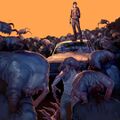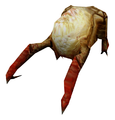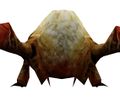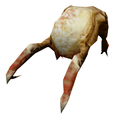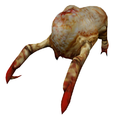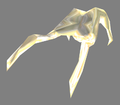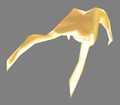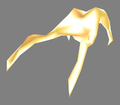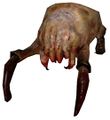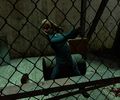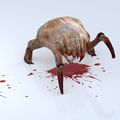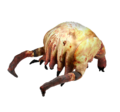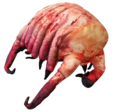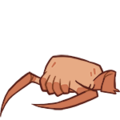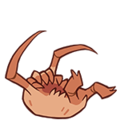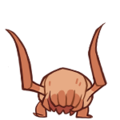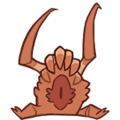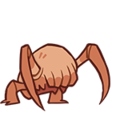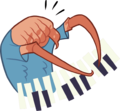Classic Headcrab
| Warning! This article has yet to be cleaned up to a higher standard of quality, per our Cleanup Project. It may contain factual errors and nonsense, as well as spelling, grammar and structure issues, or simply structure problems. Reader's discretion is advised until fixing is done. | ||
|---|---|---|
You can help clean up this page by correcting spelling and grammar, removing factual errors and rewriting sections to ensure they are clear and concise, and moving some elements when appropriate. |
| This article would greatly benefit from the addition of one or more new images. | ||
|---|---|---|
Please upload one or several relevant images (from canonical / official sources) and place it here. Once finished, this notice may be removed. |
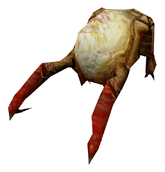 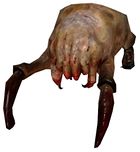 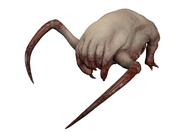
| |
| Classic Headcrab | |
|---|---|
| General information | |
| Faction |
Xen wildlife |
| Type |
Parasite |
| Personal information | |
| Health | |
| Attack(s) |
Bite |
| Game information | |
| Entity |
|
| Designer(s) | |
- "These crab creatures have a unique parasitic strategy, don't you think?"
- ― Black Mesa scientist[src]
The Classic Headcrab,[3] most commonly referred to simply as a Headcrab, is the most common Headcrab variation, having teleported to Earth in abundant numbers during the Black Mesa Incident.
Contents
Overview[edit]
Headcrabs are fairly small creatures, about two feet long from front leg to back and a foot wide. They have round, smooth, tan-colored bodies and four legs, two long clawed ones on the front and two thick, stubby ones in the back. Despite their small size, the Headcrab's back legs can support its entire body, allowing it to "tiptoe" across the ground and leap several feet into the air at its prey. Four "mouthparts" can be seen on their front that end in sharp fangs, possibly used to either hang onto a host or inject them with a sedative or some other chemical used in the zombification process. Under the body is a round, lipless mouth containing a sharp "beak" used to burrow through the host's skull. A Headcrab may weigh up to eight and a half pounds, although this is the weight of Lamarr, a well-fed Headcrab.[4]
Headcrabs can produce a variety of vocalizations. When they are not hunting, Headcrabs usually emit squeaks and fairly quiet, repetitive calls while gently swaying their bodies back and forth. When attacking, Headcrabs emit a sharp, shrill shriek as they leap towards their victims.
In Half-Life, Headcrabs are found to have originated from a giant creature known as a Gonarch which shares similar physical qualities with Headcrabs. Underdeveloped "baby" Headcrabs spawn at a rapid rate from a sac that dangles beneath the creature. Baby Headcrabs look similar to baby scorpions, being very tiny creatures with soft, translucent white bodies and some sort of "sack" where the adult mouth would be.
Behavior and skills[edit]
The Headcrab can appear harmless at a glance: it is small and slow-moving with its tiptoe-like gait. Although it can quickly leap long distances using its hind legs, tilting its body upwards to turn its mouth towards its target, such an assault can only inflict minor injuries with the claws, legs and teeth. However, the Headcrab's main goal is not to kill, but to attach itself onto an appropriate host's head. Using its leaping ability, it can reach a host's head and attempt to burrow its beak through the skull. Once successful, the Headcrab takes control of the host's nervous system and causes physical alterations to the host's body, such as causing its fingers to grow into claws, via an unknown biological process. The host then rips open its own torso, revealing the stomach and other organs, for feeding purposes. Such a Headcrab-controlled host is called a Classic Zombie (distinct from Zombies created by other Headcrab variations, which have different characteristics). In Half-Life: Alyx, headcrabs can, and will leap upon Alyx's head and force her to pry it off.
A Headcrab will frequently lie in wait in dark corners or ventilation shafts for unsuspecting prey to walk by. In more open environments, the creatures are known to bury themselves in the ground to hide, then climb out to the surface and attack when a possible host draws near. Headcrabs appear to be fairly unintelligent creatures and will pursue their prey under very dangerous conditions, moving through dangerous areas or towards hostile prey, even as fellow Headcrabs die in front of them.
Headcrabs have been observed to be prey for Bullsquids, Vortigaunts, and Barnacles. Isaac Kleiner's pet Headcrab, Lamarr, seems to have a taste for watermelons, suggesting that Headcrabs are actually omnivorous, or possibly scavengers when not looking for a host. Headcrabs have also been seen cooked and eaten by humans in Black Mesa East, which suggest that they are used as a common food source after the extinction of most of Earth's species. Citizens in Half-Life 2: Episode One comment that "They don't taste like crab."
It is also apparently possible to "tame" a Headcrab to some extent, as demonstrated by Lamarr.
Tactics[edit]
- Classic Headcrabs do not pose much of a threat to Gordon on their own. They are easily taken out, and their bite does little damage. However, they can be very irritating in combination with other enemies or in groups. Focusing on the more dangerous enemies, the player might not notice Classic Headcrabs leaping at them. In order to avoid those situations, it is preferable to keep moving at all times when Headcrabs are present. Furthermore, in Half-Life, a crowbar to the Headcrab will kill it in two swings, and only one in Half-Life 2. The primary trigger "punt" from the Gravity Gun can be used to safely repel Headcrabs, especially mid-leap; in addition, any Headcrabs who is hit by three Gravity Gun bursts will automatically die regardless of HP.
- The main threat that Headcrabs pose is their numbers. It is common to find many Classic Headcrabs, often mixed in with other types of Headcrabs. In a case involving Poison Headcrabs, the Poison Headcrabs should be killed first, as their bite will drain a player's health to 1, leaving them extremely vulnerable. In smaller groups, the 9mm Pistol is ideal against Headcrabs, since its ammunition is plentiful, but the shotgun can easily replace its role in short to medium ranges. In large groups, or when mixed with other types of Headcrabs, a weapon with a larger ammo capacity, such as the SMG, is a better choice. The shotgun is also a formidable weapon against tight groups of Headcrabs due to its spread.
Behind the scenes[edit]
- Headcrabs are very similar to Xenomorph facehuggers. Both appear as small creatures that attach themselves to their victims' heads. They also share the same skin color and make similar vocalizations.
Trivia[edit]
The Headcrab makes an appearance as a playable character in the Steam version of the video game called Super Meat Boy. It has features that differ from the other characters in the game such as the ability to stick to walls and a more horizontal jump.
Gallery[edit]
Pre-release[edit]
Half-Life Alpha[edit]
Half-Life[edit]
Concept art of Headcrab Zombie, with original Headcrab design.
OEM version.
Half-Life 2[edit]
Headcrab model used for the Zombie Assassin.
Half-Life: Alyx[edit]
Unused artwork featuring Zombies and Headcrabs surrounding Alyx.
Retail[edit]
Half-Life[edit]
Dreamcast version.
Dreamcast version.
Headcrab being dissected in Half-Life: Decay.
Half-Life 2[edit]
Half-Life 2: Deathmatch "Head Humper" spray.
Half-Life 2 model, updated with phong for The Orange Box.
Half-Life: Alyx[edit]
Shrinkwrapped Headcrab in the fridge of Russell's Lab.
Gary shows his catch of Headcrabs.
Other[edit]
Steam trading card featuring a creep named Alyx with a Headcrab.
Headcrab jump scare in The Final Hours of Half-Life: Alyx.
Steam 20th Anniversary artwork parodying Keyboard Cat.
List of appearances[edit]
Main games[edit]
- Half-Life
- Half-Life: Opposing Force
- Half-Life: Blue Shift
- Half-Life: Decay
- Half-Life 2
- Half-Life 2: Episode One
- Half-Life 2: Episode Two
- Half-Life: Alyx
Other[edit]
- Half-Life: Day One (First appearance)
- Half-Life: Uplink (Non-canonical appearance)
- Half-Life 2: Raising the Bar
- Source Particle Benchmark (Non-canonical appearance)
References[edit]
- ↑ 1.0 1.1 Half-Life 2 Prima Guide
- ↑ Half-Life 2: Raising the Bar, page 74
- ↑ Half-Life 2 texture and model file names
- ↑ Half-Life 2: Episode Two
